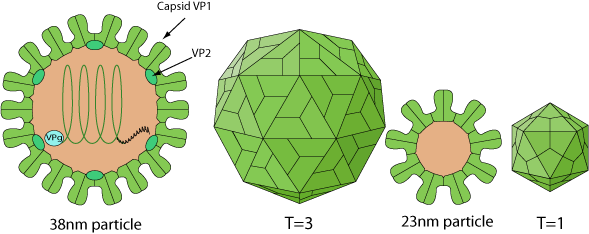Norovirus (taxid:142786)
VIRION

Non-enveloped, capsid of about 38-40 nm in diameter, with T=3 icosahedral symmetry. The capsid is composed of 180 VP1 proteins. Small empty virions are about 23nm in diameter, and would be of T=1 icosahedral symmetry, composed of 60 VP1 proteins.
GENOME
Monopartite, linear ssRNA(+) genome of 7.3 to 8.3 kb. The 5'-terminus is linked to a VPg protein and the 3'-terminus has a poly(A) tract.n (VPg)is covalently linked to genome, whereas 3'-terminus is polyadenylated.
GENE EXPRESSION
The virion RNA is infectious and serves as both genome and viral messenger RNA. Cleavage of ORF1 polyprotein by the virus-encoded 3C-like cysteine proteinase yields the mature nonstructural proteins. Subgenomic RNA encodes the capsid protein and VP2 minor structural protein which is expressed through RNA termination-reinitiation. Murine norovirus express an alternative ORF from the CP mRNA by leaky scanning.
ENZYMES
- RNA-dependent RNA polymerase [RdRp Q83883]
- VPG-type capping [VPg Q83883]
- NTPase-helicase [NTPase Q83883]
- Polyprotein major protease (Peptidase C37) [3CLpro Q83883]
REPLICATION
CYTOPLASMIC
- Attachement to host receptors mediates clathrin- and caveolin-independent endocytosis of the virus.
- Uncoating, and release of the viral genomic RNA into the cytoplasm.
- VPg is removed from the viral RNA, which is then translated into a processed ORF1 polyprotein to yield the replication proteins.
- Replication occurs in viral factories. A dsRNA genome is synthesized from the genomic ssRNA(+).
- The dsRNA genome is transcribed/replicated thereby providing viral mRNAs/new ssRNA(+) genomes.
- Subgenomic RNA translation gives rise to the capsid protein and VP2.
- Assembly of new virus particles and release by cell lysis.
Host-virus interaction
Apoptosis modulation
Murine norovirus induces host cell apoptosis

 .
.
Host gene expression shutoff by virus
Noroviruses mediate host translation shutoff by cleaving PABP1
 .
.
Matching UniProtKB/Swiss-Prot entries
(all links/actions below point to uniprot.org website)12 entries grouped by strain
3 entries
Norovirus (strain Human/NoV/United States/Norwalk/1968/GI) (Hu/NV/NV/1968/US) reference strain
3 entries
Lordsdale virus (strain GII/Human/United Kingdom/Lordsdale/1993) (Human enteric calicivirus) (Hu/NV/LD/1993/UK)
3 entries
Norovirus (isolate Mouse/NoV/United States/MNV1/2002/GV) (MNV-1) (Murine Norovirus 1)
3 entries
Southampton virus (strain GI/Human/United Kingdom/Southampton/1991) (SHV) (Hu/NV/SHV/1991/UK)
Norovirus GIII taxid:340017
| Protein | ModelArchive |
| Capsid | ma-jd-viral-54537 |
| VP2 | ma-jd-viral-36156 |
